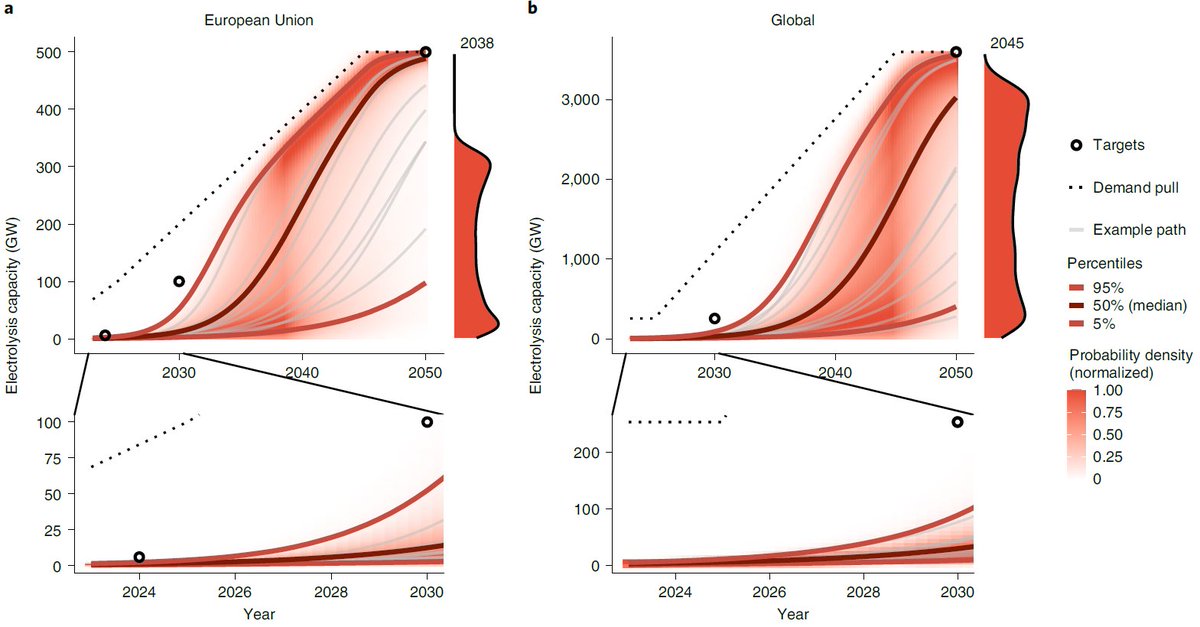
🚨 New paper 🚨
Green #hydrogen and derived #efuels are critical for #climate #mitigation, but when will they be available at scale?
In a new Nature Energy study, we look at a key bottleneck: the market ramp-up of #electrolysis capacity.
Summary 🧵⬇️
nature.com/articles/s4156…
Green #hydrogen and derived #efuels are critical for #climate #mitigation, but when will they be available at scale?
In a new Nature Energy study, we look at a key bottleneck: the market ramp-up of #electrolysis capacity.
Summary 🧵⬇️
nature.com/articles/s4156…
2/ #GreenHydrogen, produced from renewable electricity via electrolysis, is vital for the #EnergyTransition. In the #EnergyCrisis hydrogen is also considered an option to limit Europe's fossil fuel imports.
However, scaling up supply is a huge challenge!
However, scaling up supply is a huge challenge!
3/ There's a lot of momentum in electrolysis project announcements. This is also much needed because global capacity needs to grow a staggering 6,000-8,000-fold from 2021-2050 to meet #NetZero scenarios. Yet, most projects still lack an FID, making them uncertain. 

4/ The market ramp-up of electrolysis can therefore be characterised by three uncertainties:
1️⃣ How many projects will materialise in the short term?
2️⃣ What growth rates are feasible in the mid- to long-term?
3️⃣ How quickly will demand for green hydrogen expand?
1️⃣ How many projects will materialise in the short term?
2️⃣ What growth rates are feasible in the mid- to long-term?
3️⃣ How quickly will demand for green hydrogen expand?
5/ To answer these questions, we build a probabilistic technology diffusion model, which we parameterise with electrolysis project data, growth from technology analogues, and policy targets and scenario results. We explore and aggregate ten thousand pathways (MC simulation). 

6/ Three key insights emerge:
1️⃣ Even if electrolysis capacity grows as fast as #wind and #solar power, green hydrogen remains scarce for at least 1-2 decades and likely supplies <1% of final energy until 2030 in the EU and 2035 globally.
👉 Short-term scarcity
1️⃣ Even if electrolysis capacity grows as fast as #wind and #solar power, green hydrogen remains scarce for at least 1-2 decades and likely supplies <1% of final energy until 2030 in the EU and 2035 globally.
👉 Short-term scarcity

7/ Specifically, reaching the recently raised #REPowerEU target of 10 Mt domestic production of renewable hydrogen by 2030 (~100 GW electrolysis capacity) requires growth rates that are unprecedented for energy technologies.
8/
2️⃣ A breakthrough to high electrolysis capacity is possible, but timing and magnitude are uncertain. In the EU, the breakthrough occurs ~2038, globally ~2045. By then, feasible capacities under wind/solar-like growth span a very wide range.
👉 Long-term uncertainty
2️⃣ A breakthrough to high electrolysis capacity is possible, but timing and magnitude are uncertain. In the EU, the breakthrough occurs ~2038, globally ~2045. By then, feasible capacities under wind/solar-like growth span a very wide range.
👉 Long-term uncertainty
9/
3️⃣ There's a pronounced bimodal distribution (two local maxima) near the breakthrough point, further increasing uncertainty.
👉 Bad for risk management
Short-term scarcity and long-term uncertainty pose challenges for policymakers, system planners, and industry.
3️⃣ There's a pronounced bimodal distribution (two local maxima) near the breakthrough point, further increasing uncertainty.
👉 Bad for risk management
Short-term scarcity and long-term uncertainty pose challenges for policymakers, system planners, and industry.
10/ Sounds disappointing?
We also explore what might be possible for #GreenHydrogen under emergency deployment. Unconventionally high growth rates (technologies in panel a) mitigate short-term scarcity and long-term uncertainty, keeping the 2030 #REPowerEU target in reach.
We also explore what might be possible for #GreenHydrogen under emergency deployment. Unconventionally high growth rates (technologies in panel a) mitigate short-term scarcity and long-term uncertainty, keeping the 2030 #REPowerEU target in reach.

11/ What's needed to realise such unconventionally high growth rates for green hydrogen?
Special dedication, coordination and funding! Policies need to secure business cases through co-financing or direct investments along the whole H2 value chain. Also, CO2 pricing, of course!
Special dedication, coordination and funding! Policies need to secure business cases through co-financing or direct investments along the whole H2 value chain. Also, CO2 pricing, of course!
12/ Unconventional growth rates accelerate the breakthrough to ~2030, reducing short-term scarcity and securing long-term availability. However, even then, reaching the @IEA #NZE scenario of 850 GW global capacity by 2030 remains unlikely (panel e). 

13/ Summing up, under wind/solar-like growth #GreenHydrogen supply suffers from short-term scarcity and long-term uncertainty. Both are two sides of the same coin and could be resolved together by policies that kick-start rapid Gigawatt-scale electrolysis deployment.
14/ Even though #GreenHydrogen is critical for #ClimateChange mitigation, it's no panacea and policy makers should be aware that there remains a risk of overestimating its potential. Reducing emissions requires an accelerated roll-out of all crucial #ZeroCarbon technologies.
15/ Please do approach us for questions, feedback and remarks.
Thanks a lot to all co-authors @FalkoUeckerdt, @GregNemet, @mhjnstrl, @GunnarLuderer, as well as funding agencies @AriadneProjekt and @umweltstiftung.
#EnergyTwitter #ClimateCrisis
Thanks a lot to all co-authors @FalkoUeckerdt, @GregNemet, @mhjnstrl, @GunnarLuderer, as well as funding agencies @AriadneProjekt and @umweltstiftung.
#EnergyTwitter #ClimateCrisis
Also, here's the free view-only link to our paper:
rdcu.be/cVdvI
rdcu.be/cVdvI
• • •
Missing some Tweet in this thread? You can try to
force a refresh




